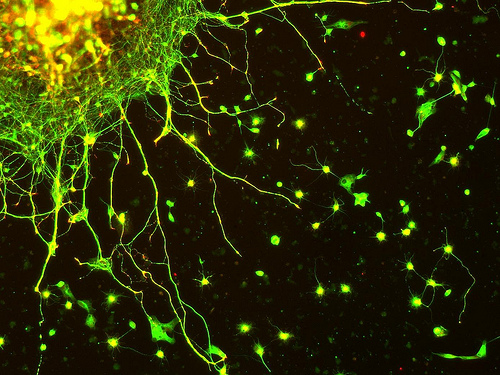
Photo by thelunch_box
Warren Karlenzig held recently a talk at TEDxMission on collaborative intelligence for the smart city. He reminds us that urbanization is a major driver to our development in the coming decades and that cities are complex systems which result from sub-systems interacting with one another. A good example of complex system is the brain. A recent publication on a previously unknown cleansing mechanism makes a parallel with hydraulic systems: once opened, you break the connections, and can no longer be studied. Scientists are using technology to study the system in operation, intact. Something urban planners could only dream of…
Cities As Complex Systems
City sub-systems include public health, education, public safety, biodiversity, policy and regulation, transportation, communication or utilities. In his talk, Karlenzig gives a number of examples spanning these which show how citizens are able to coordinate their efforts to reduce their impact on the environment. He highlights the use of technology for bottom-up management of scarce resources.
I have touched previously on similar projects on this blog as I believe that the complexity of the systems in focus (cities) is such that traditional top-down management cannot address the challenges. Behind the very clever uses of technology these projects demonstrate, hide fundamental questions about governance which would guide the execution of successful citizen sensing at the service of the city and its inhabitants. Here, we seem caught in the classical conundrum of large organizations dealing with centralized vs. decentralized control. The point of decentralized governance in a complex World was made a year ago in publicservice.co.uk by Jill Rutter.
In a world of decentralization and complex problems with multiple actors, policymakers will need to recognize that many of the real policy decisions are being made well beyond the confines of Whitehall and Westminster
Jill Rutter, program director at the Institute for Government and co-author of Policy Making in the Real World
Steering Complex Systems
To begin addressing this governance challenge in light of the powerful crowdsourcing technologies at our disposal, we need to reflect on centralized vs. decentralized. I believe this is best done using management cybernetics and the principles behind the Viable System Model of Stafford Beer. As Raúl Espejo of Syncho Research indicated, Management cybernetics provides a way to look at the traditional dichotomy through the lenses of variety engineering. Variety here refers to the number of states a system and its environment can take. Viability of a system comes when these are balanced. Management cybernetics breaks the system-in-focus into several levels of recursion each managing its own environmental variety. This view of the organization rests on the notion that the system is made of autonomous units which are able to steer and adapt to its environment. What connects the autonomous parts to its whole (often across multiple Russian Matryoshka dolls) are homeostats which balance variety. Here is a short video by Paul Pangaro which provides additional insights on cybernetics and its significance.
Citizen Sensing
Collective intelligence provides yet another iteration in the way we produce stuff. It has been used in citizen sensing, software development, and crowd solving. It is now also being considered to address key sustainability issues such as food production, air pollution or water supply. Cities are facing greater constraints in costs while dealing with increased demands in resilience through innovation. Current citizen sensing initiatives, including hard sensing projects by sensemakers or soft sensing deployments of Ushahidi, indicate novel ways to involve the citizen and study systems in operation. Both approaches are needed: while hard sensing enhances our 5 senses and provides continuous readings of data, soft sensing sources provenance, context and human-specific indicators. The use of crowdsourcing is also leading to Big Data or the need to manage more data that fits into a single machine or can be handled in a single request. Gathering vasts amounts of low-fidelity, high-frequency data will require powerful filters and analytics to exploit the data across distributed locations.
It seems to me that incumbent organizations are having a hard time experimenting, let alone adopting, these new approaches. Even high-visibility projects such as Air Quality Egg are operating independently of environmental agencies in Europe or the US. None, aside perhaps from crisis management propeller heads, seem to be addressing governance aspects related to crowdsourcing. Urban intelligence organizations such as New Cities Foundation are perhaps better positioned to innovate and coach cities in adopting these new approaches while addressing the important aspects of governance which are still left aside.
City Task Force
I also feel we are facing challenging times. Global warming, over-population are two important threats that will put cities to the test. Recognizing that most of humanity will be concentrated in urban ecosystems, is a good way to focus on places that will make a difference. But cities need now to go beyond their visions of e-Government and incorporate participatory services which let citizens perform meaningful, actionable micro-actions such as building sensors, collecting or analyzing data. These micro-actions will play important roles in balancing complex systems with many moving parts. The services offered to citizens will require innovative business models to viably support citizen sensing task forces, continuously active inside the city and at its edge. These task forces will materialize new first-order and second-order feedback loops which will be a way for us to better deal with the rapid and drastic changes in our environment. That’s at least what I hope…
 This material is licensed under CC BY 4.0
This material is licensed under CC BY 4.0
